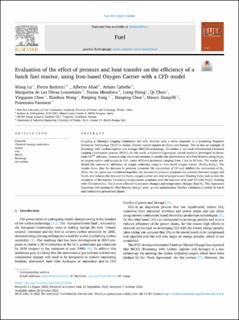| dc.contributor.author | Lu, Wang | |
| dc.contributor.author | Bartocci, Pietro | |
| dc.contributor.author | Abad, Alberto | |
| dc.contributor.author | Cabello, Arturo | |
| dc.contributor.author | Obras Loscertales, Margarita de las | |
| dc.contributor.author | Mendiara, Teresa | |
| dc.contributor.author | Wang, Liang | |
| dc.contributor.author | Chen, Qi | |
| dc.contributor.author | Chen, Yingquan | |
| dc.contributor.author | Wang, Xianhua | |
| dc.contributor.author | Yang, Haiping | |
| dc.contributor.author | Chen, Haiping | |
| dc.contributor.author | Zampilli, Mauro | |
| dc.contributor.author | Fantozzi, Francesco | |
| dc.date.accessioned | 2022-11-03T09:21:53Z | |
| dc.date.available | 2022-11-03T09:21:53Z | |
| dc.date.created | 2022-10-31T15:44:30Z | |
| dc.date.issued | 2022 | |
| dc.identifier.issn | 0016-2361 | |
| dc.identifier.uri | https://hdl.handle.net/11250/3029763 | |
| dc.description.abstract | Coupling a Chemical Looping Combustor fed with biofuels with a turbo expander is a promising Negative Emissions Technology (NET) to realize climate neutral targets in China and Europe. This is also an example of Bioenergy with Carbon Capture and Storage (BECCS) technology. To realize it, we need a Pressurized Chemical Looping Combustion process (PCLC). In this work, a Eulerian-Lagrangian hybrid model is developed in Barracuda-VRTM software, incorporating chemical reactions to predict the performance of a Fuel Reactor using Fe2O3 as oxygen carrier and syngas as fuel, under different pressures, ranging from 1 bar to 20 bars. The model predicted the conversion efficiency of syngas reduction using an iron-based oxygen carrier (Fe2O3/Al2O3). The results show, that the increase in pressure promotes the conversion of CO and inhibits the conversion of H2. When the two gases are considered together, the increase in pressure promotes the reaction between syngas and Fe2O3 and reduces the demand for Fe2O3 oxygen carrier per unit of syngas Lower Heating Value and so also the inventory of the reactor. Increasing temperatures promotes both the reaction of H2 and CO with Fe2O3. Dealing with CO conversion, this is more affected by pressure changes and temperature changes than H2. This represents important information for Fuel Reactor design, scale up and optimization. Further validation is neded in batch and continuous pressurised plants. © 2022 The Author(s) | en_US |
| dc.description.abstract | Evaluation of the effect of pressure and heat transfer on the efficiency of a batch fuel reactor, using Iron-based Oxygen Carrier with a CFD model | en_US |
| dc.language.iso | eng | en_US |
| dc.publisher | Elsevier | en_US |
| dc.rights | Navngivelse 4.0 Internasjonal | * |
| dc.rights.uri | http://creativecommons.org/licenses/by/4.0/deed.no | * |
| dc.title | Evaluation of the effect of pressure and heat transfer on the efficiency of a batch fuel reactor, using Iron-based Oxygen Carrier with a CFD model | en_US |
| dc.title.alternative | Evaluation of the effect of pressure and heat transfer on the efficiency of a batch fuel reactor, using Iron-based Oxygen Carrier with a CFD model | en_US |
| dc.type | Peer reviewed | en_US |
| dc.type | Journal article | en_US |
| dc.description.version | publishedVersion | en_US |
| dc.rights.holder | The Authors | en_US |
| dc.source.volume | 333 | en_US |
| dc.source.journal | Fuel | en_US |
| dc.source.issue | 1 | en_US |
| dc.identifier.doi | 10.1016/j.fuel.2022.126266 | |
| dc.identifier.cristin | 2066990 | |
| dc.relation.project | EC/H2020/101018756 | en_US |
| dc.source.articlenumber | 126266 | en_US |
| cristin.ispublished | true | |
| cristin.fulltext | original | |
| cristin.qualitycode | 2 | |

